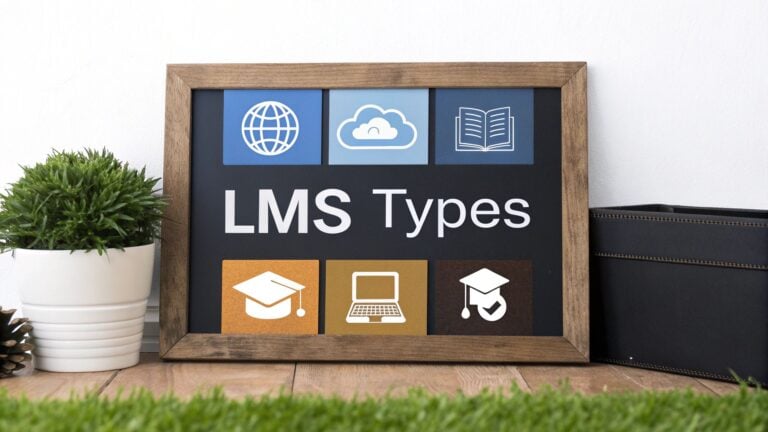How To Structure Microlearning Content

Picture this: You’re sitting at your desk, coffee getting cold, staring at a 45-minute training module titled “Essential Workplace Communication Skills.” Your calendar shows three back-to-back meetings starting in 20 minutes. Sound familiar?
This scenario plays out thousands of times daily across organizations worldwide. We live in a world where the average knowledge worker gets interrupted every 11 minutes, yet we’re still designing learning experiences that demand hours of uninterrupted focus. Enter microlearning: bite-sized, just-in-time education designed for today’s distracted, mobile-first workforce.
Effective microlearning requires intentional structure. It’s about strategic design that maximizes learning impact within tight time constraints. By the end of this post, you’ll have a proven framework that transforms overwhelming topics into engaging, memorable micro-experiences that actually stick.
Why Structure Makes or Breaks Microlearning
Think about the last time you tried to learn something new from a poorly organized YouTube video. You probably clicked away within 30 seconds, right? The same principle applies to workplace learning, except the stakes are higher.
When microlearning content lacks proper structure, a couple things happen.
First, cognitive overload kicks in even faster than with longer content. Our brains can only process so much information at once, and without clear organization, even a 3-minute lesson can feel overwhelming.
Second, learners lose context quickly. They finish a micro-module and think, “Okay, that was interesting, but what am I supposed to do with this information?”
Aberdeen Group research reveals something striking about this challenge. Organizations using structured microlearning approaches see information retention rates improve by 25-60% compared to traditional training methods. That’s not a small difference. We’re talking about the gap between learners remembering half of what they learned versus forgetting most of it within a week.
The business impact goes beyond retention rates too. The Association for Talent Development found that companies implementing structured microlearning programs report 50% higher engagement rates and a 42% increase in revenue per employee.
The secret lies in understanding how our brains process information. We naturally look for patterns, connections, and logical sequences. When microlearning content provides this structure, it works with our cognitive processes instead of against them. When it doesn’t, even the most engaging content falls flat.
The MICRO-STRUCTURE Framework

After analyzing hundreds of successful microlearning implementations across industries, a clear pattern emerges. The most effective programs follow what I call the MICRO-STRUCTURE framework. It’s not complicated, but each step builds on the previous one to create learning experiences that truly work.
Step 1: Map to a Single, Specific Learning Objective
This sounds basic, but most microlearning fails right here. Your objective needs to pass what I call the “elevator test.” If you can’t explain what learners will be able to do after completing your content in the time it takes an elevator to go up three floors, your objective is too broad.
Good microlearning objectives use action verbs from Bloom’s Taxonomy and focus on performance, not knowledge absorption. Instead of “Understand customer service principles,” try “Identify three techniques to de-escalate angry customer interactions.” Instead of “Learn about cybersecurity,” go with “Recognize five common phishing email indicators.”
Here’s a quick test for your objectives: Can you assess whether someone achieved it with 2-3 questions? If not, you’re trying to cover too much ground. Remember, microlearning succeeds through focus, not comprehensiveness.
Step 2: Intelligently Chunk Your Content
Once you have your focused objective, you need to break down your content using proven cognitive patterns. The human brain processes information more effectively when it follows familiar structures.
The Pyramid Method works well for most topics. Start with the big picture (why this matters), drill down to specifics (the key concepts), then end with application (what to do next). For troubleshooting skills, try Problem-Solution-Action sequencing. Present the challenge, offer the solution, then guide implementation.
Tell-Show-Do remains one of the most effective patterns for procedural knowledge. Explain the concept briefly, demonstrate it with a concrete example, then provide an opportunity for immediate practice.
Each chunk should contain one concept, use one primary media type, and include one interaction. This might seem restrictive, but constraints actually boost creativity and effectiveness. When you try to pack multiple concepts into a single chunk, learners lose focus and retention plummets.
Step 3: Choose Format Based on Learning Goal
Format selection isn’t about what looks cool or what’s trending on social media. It’s about matching the medium to the learning goal and the learner’s context.
Interactive scenarios work brilliantly for decision-making skills because they let learners explore consequences in a safe environment. Short videos (60-90 seconds maximum) excel at showing procedures or demonstrating techniques. Infographics shine when learners need quick reference information they’ll return to later. Audio snippets can be perfect for storytelling or culture-building content that learners can consume while commuting.
Consider where and when your learners will access this content. Are they at their desks with large screens and stable internet? Or are they frontline workers grabbing training moments between customer interactions on mobile devices? The context should drive format decisions as much as the content itself.
Step 4: Design for Active Engagement
Passive consumption kills microlearning effectiveness. If learners can complete your content while thinking about their grocery list, you’ve missed the mark. Aim for meaningful interaction every 30-45 seconds, but make sure each interaction serves a purpose beyond just keeping people awake.
Scenario-based learning consistently outperforms abstract examples because it connects to real workplace situations. Instead of asking, “Which of these is the correct definition of active listening?” try “Your colleague seems frustrated during your project meeting. What’s your best first response?”
Progressive disclosure keeps learners curious and engaged. Instead of presenting all information upfront, reveal details based on learner choices and interests. This approach mimics natural conversation and discovery patterns.
Mobile-first design isn’t optional anymore. Even if your organization primarily uses desktop computers, learners increasingly expect to access content on their phones during commutes or breaks. Touch-friendly interfaces and thumb-reachable buttons aren’t just nice features; they’re necessities.
Step 5: Reinforce with Strategic Micro-Assessments
Assessment in microlearning serves a different purpose than traditional testing. You’re not evaluating learners; you’re reinforcing learning and identifying gaps while there’s still time to address them.
Keep assessments low-stakes but high-value. One to three questions maximum, focusing on application rather than recall. Scenario-based questions consistently outperform factual recall because they mirror real-world application.
| Assessment Type | Best For | Example |
|---|---|---|
| Scenario-based multiple choice | Decision-making skills | “A customer complains about wait time. Your best response is…” |
| Drag-and-drop | Categorization and process order | “Arrange these steps in the correct sequence” |
| Hotspot clicking | Visual identification | “Click on the safety hazards in this workplace photo” |
The feedback you provide matters more than the questions themselves. Instead of just marking answers right or wrong, explain why the correct choice works and why alternatives don’t. This turns assessment into additional learning opportunities rather than just evaluation moments.
Step 6: Optimize for Long-term Retention
Microlearning’s biggest challenge isn’t getting people to complete content; it’s ensuring they remember and apply what they learned. This is where spaced repetition and application support become crucial.
Build in follow-up touchpoints that arrive when learners are most likely to forget key information. The forgetting curve tells us that we lose about 50% of new information within an hour unless we actively work to retain it. A brief follow-up message three days after completion can dramatically improve retention rates.
Application challenges bridge the gap between learning and doing. Instead of ending with “Congratulations, you’ve completed this module,” try “Before your next customer interaction, practice using one of these de-escalation techniques. Share your experience in the discussion forum.”
Connection to performance support tools makes microlearning more valuable over time. Link to job aids, quick reference materials, or decision trees that learners can access when they need help applying what they’ve learned.
Avoiding the Most Common Structural Mistakes

Even with the best intentions, certain pitfalls consistently trip up microlearning designers. Content cramming tops the list. You can’t take a comprehensive topic and simply compress it into a shorter timeframe without strategic editing. This approach creates cognitive overload and frustration.
Missing the relevance hook causes immediate disengagement.
Learners need to understand within the first 15 seconds why this content matters to them right now. Starting with background information or theoretical foundations kills momentum before it builds.
Interaction overload represents the opposite extreme.
Some designers think more interactivity automatically means better engagement. But poorly planned interactions distract from learning goals rather than supporting them. Every click, drag, or tap should move learners closer to mastery.
Assessment afterthoughts damage learning effectiveness.
When you bolt evaluation onto the end of content without integrating it naturally, learners perceive it as a hurdle to completion rather than a learning reinforcement tool.
Platform myopia creates unnecessary barriers.
Designing exclusively for desktop computers when your learners primarily use mobile devices guarantees poor adoption rates. Similarly, creating content that requires high-bandwidth internet connections won’t work for field-based employees.
Structure in Action
Let me share a hypothetical example that illustrates these principles in practice.
A global retail chain is struggling with product training effectiveness. Their original approach involves 45-minute modules covering multiple product lines, complex feature comparisons, and detailed technical specifications. Completion rates hovered around 34%, and knowledge retention tests showed disappointing results.
Using the MICRO-STRUCTURE framework, they redesign the entire program. Each 4-minute module focused on a single product with one clear learning objective: “Identify the three key selling points for [specific product] and explain one benefit for different customer types.”
The content structure followed the Tell-Show-Do pattern.
- First, a 30-second overview explaining why these selling points matter to sales success.
- Then, a 90-second interactive scenario showing conversations with different customer types.
- Finally, a 60-second practice opportunity where learners selected appropriate selling points for various customer profiles.
Mobile-optimized scenarios let sales associates complete training during quiet moments on the sales floor. Immediate feedback helps reinforce learning, and spaced repetition messages arrived three days and one week after completion with additional tips and reminders.
In this example, you can see how the company’s employees benefits from a micro-first approach. It helpst hem do their job better, instead of getting in the way of them doing their job.
Making It Work for You
The difference between effective microlearning and digital PowerPoint slides comes down to intentional structure. The MICRO-STRUCTURE framework provides a blueprint, but successful implementation requires commitment to the process and willingness to prioritize learner needs over content coverage.
Start with your most urgent training challenge. Apply the single learning objective test first. If you can’t assess achievement with three questions or fewer, break the topic down further. This exercise alone will improve your training effectiveness significantly.
Remember that microlearning succeeds through consistency and connection, not individual brilliance. A series of well-structured, connected micro-experiences creates more impact than standalone masterpieces. Plan your content ecosystem, not just individual modules.






![How to Effectively Host Webinars Using OBS Studio [Guide from Expert]](https://learnstream.io/wp-content/uploads/2024/08/image-768x333.png)